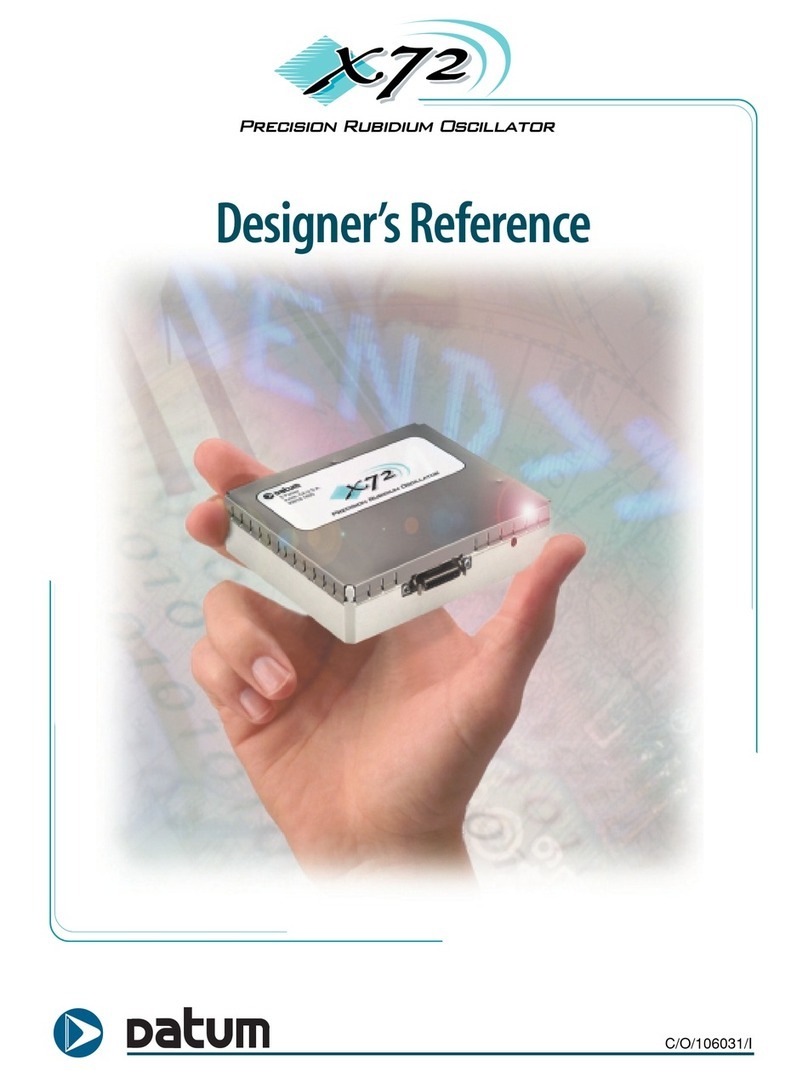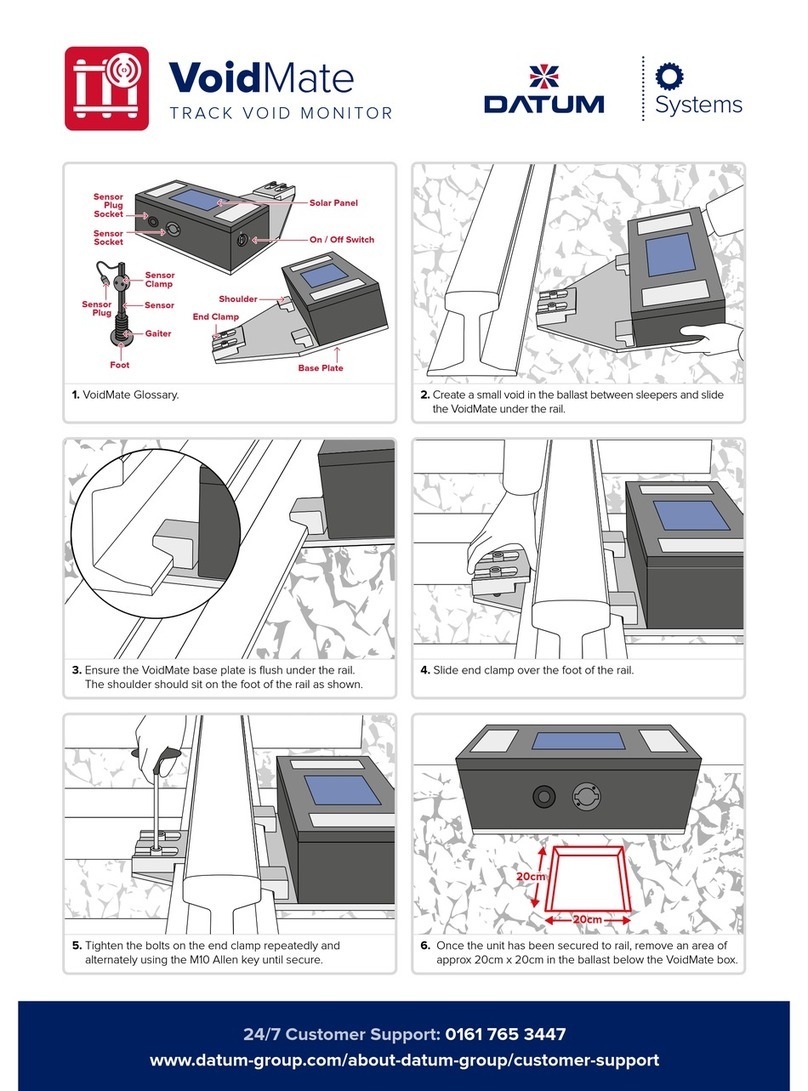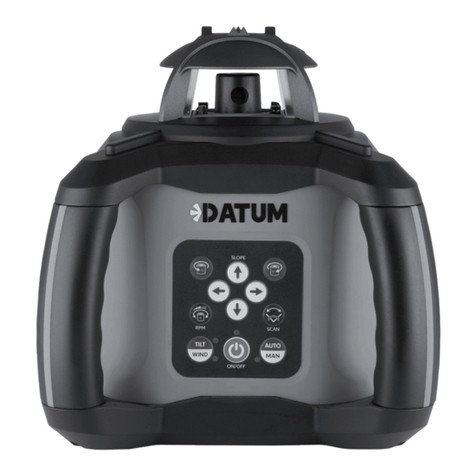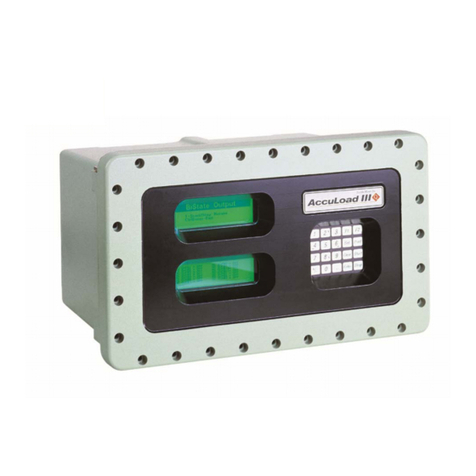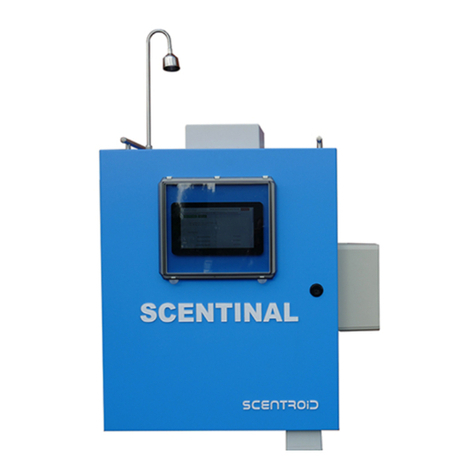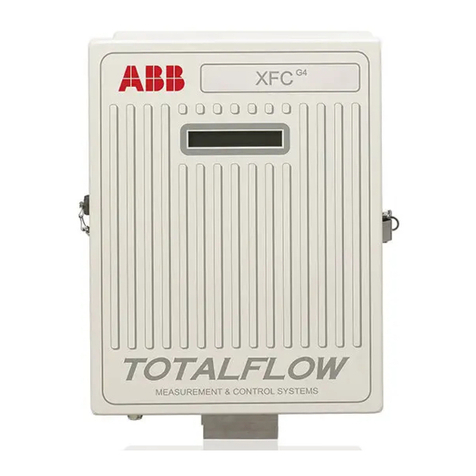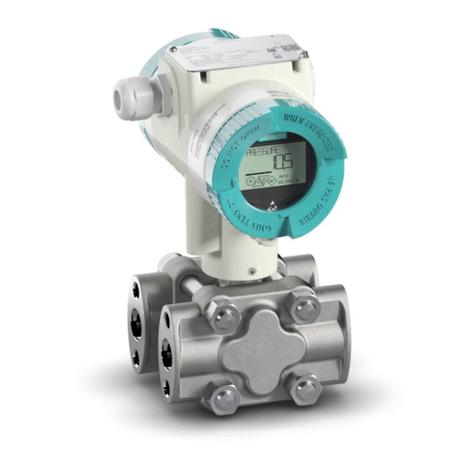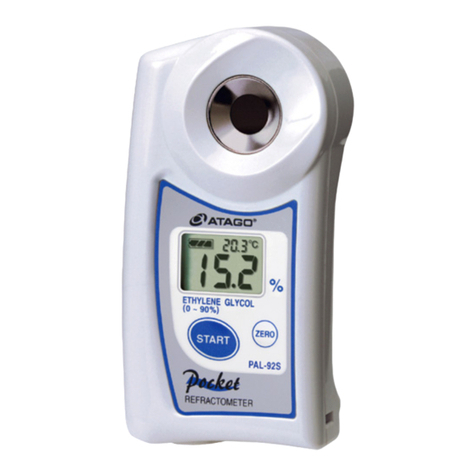Datum 4040B User manual

4040B Caesium Time & Frequency Standard
OPERA
OPERATING MANUAL
TING MANUAL
4040B
4040B #08518-201, REV AG
#08518-201, REV AG


Copyright Notice
4040B
COPYRIGHT 2001 DATUM - TT&M ALL RIGHTS RESERVED
This manual is provided to assist the user in the operation and maintenance of the supplied equipment
or software. It is recognized that multiple copies may be required to support even a single unit, and
for this reason, permission is hereby granted to reproduce the supplied User’s Guide for the purpose
stated above, provided that this notice is included as part of the copy. Additional copies are also
available from Datum - TT&M for a nominal fee.
In no case, however, does the supply of this manual or the granting of rights to reproduce the manual,
grant any rights to use information contained within to reproduce the supplied equipment or software,
either in whole or in part.
The equipment or software described in this manual have been developed solely at the expense of
Datum - TT&M and are proprietary. No unlimited rights in technical data are granted. Limited rights
as per DFARS 252.227-7013 shall be effective for 10 years from the copyright date.
I

TABLE OF CONTENTS
II
CHAPTER ONE
Introduction/Product Overview 1
Instrument Identification 1
About This Manual 2
Typographical and Other Conventions 3
Instrument Identification 3
CHAPTER TWO
Installation 6
Environment 6
Mounting 6
Electrical Connections 6
External DC Connections 7
Unit Certifications 7
Preparation for Shipment 9
CHAPTER THREE
Operation 12
Turn-On Procedure 12
Operational Check 13
Connections to RS232 Interface 14
Start-Up Phase 14
Turn-On Without PC 15
PC-Assisted Turn-On 15
1 PPS Output 16

III
TABLE OF CONTENTS
CHAPTER FOUR
Remote Control Software 18
Monitor.exe Software 18
Setting Up the Serial Link 19
Operating Instructions 20
Parameters 21
Alarms 25
Minor Alarm Messages 25
Major Alarm Messages: (without tube shutdown) 25
Major Alarm Messages: (resulting in tube shutdown) 26
Graphic Display 27
Miscellaneous Functions 28
Format of ASCII Strings Transmitted & Received at the PC 29
Remote Control On 29
Remote Control Off 29
Request Variables Data Message 30
Request Constants Data Message 31
Remote Control Commands 32
CHAPTER FIVE
Specifications 33
Performance 33
Outputs 34
Controls 34
General 34
Environment 35
Options 37
Monitor Pin-Out 38
Storage/Shelf Life 41
CHAPTER SIX
Options 42
Option 063 – DS1 Frequency Synthesizer 42
Option 063 Specifications 44
Operation 45
Theory of Operation 47
Option 064 – CEPT Frequency Synthesizer 49
Option 064 Specifications 52
Installation 53


1
INTRODUCTION/PRODUCT OVERVIEW
The Datum 4040B CaesiumTime and Frequency Standard is a primary frequency and time reference
with microprocessor control. The major function of the Datum 4040B is to produce accurate, stable,
and spectrally pure sinusoidal signals, and precise timing signals. To accomplish this, a caesiumbeam
tube resonator is used to stabilize the output of a quartz crystal oscillator.
A microprocessor is used to perform the following tasks:
• Digital demodulation and integration of the servo loop signals
• Monitoring of system parameters
• Control of adaptive servos
• Diagnostic functions to aid in troubleshooting
The Datum 4040B operates from 90/240 VAC or 22 to 56 VDC.
FIGURE 1-1. DATUM 4040B FRONT AND REAR PANELS
Chapter One
4040B

4040B
WHO SHOULD READ THIS OPERATING MANUAL?
This Operating Manual is designed for the following categories of users:
Systems Engineers – Chapter Two provides installation procedures. Chapter Three details operating
procedures, and Chapter Four defines the format and communication protocol for the serial input/out-
put control port. Finally, Chapter Five lists detailed specifications for the Datum 4040B.
Installation Engineers – Chapter Two and three provide the bulk of the information needed for suc-
cessful installation and validation of operation.
ABOUT THIS OPERATING MANUAL
This Operating Manual is intended to be used as a reference for the Datum 4040BCaesiumTime and
Frequency Standard. This Operating Manual has an introduction to the Datum 4040B, followed by pro-
cedures for installation, power-up, and operation.
This Operating Manual contains the following chapters and appendices:
• Chapter One – Introduction/Product Overview: This chapter includes an overview of this Operating
Manual, the intended audience, and the stylistic and typographical conventions used.
• Chapter Two – Installing the Datum 4040B: Describes initial inspection of the 4040B, preparation for
use, and signal interconnections.
• Chapter Three – Operation: Describes the local operation of the 4040B.
• Chapter Four – Remote Control Software: Describes the protocol and data available through the RS-
232C Input/Output serial port.
• Chapter Five – Specifications: Describes the system specifications information.
• Chapter Six – Options: Describes options 063 and 064.
2

4040B
TYPOGRAPHICAL AND OTHER CONVENTIONS
This Operating Manual uses the following conventions:
Acronyms and Abbreviations – Terms are spelled out the first time they appear in this
Operating Manual. Thereafter, only the acronym or abbreviation is used. In addition, the glossary
defines the acronyms and abbreviations.
Revision Control – The title page lists the printing date and part number of this Operating Manual.
Table 1-1 describes the typographical conventions that this Operating Manual uses to
distinguish between the different types of information according to how they are used.
TABLE 1-1. TYPOGRAPHICAL CONVENTIONS
INSTRUMENT IDENTIFICATION
A slash (/) and a three-digit number, following the four-digit model number (4040B) specifies an option
that is supplied within the instrument. See Chapter Five for a list of available options. Chapter Six pro-
vides descriptions for Options 063 and 064.
3
WHEN TEXT APPEARS THIS WAY ... IT MEANS ...
4040B Operating Manual
The title of a document or the name of
a product
CRITICAL PORT-1 J1 An operating mode, alarm state, status or
chassis label.
Press the Enter Key A named keyboard key. The key name is shown
as it appears on the keyboard. An explanation
Press the Print Scrn Key of the keys acronym or function immediately
follows the first reference to the key, if required.
A
re-timing
application ... A term or word being emphasized.
Datum does not recommend ... A word or term given special emphasis so that
you do not miss the idea being presented.

4040B
WARNINGS, CAUTIONS, RECOMMENDATIONS, AND NOTES
Warnings, Cautions, Recommendations, and Notes attract attention to essential or critical
information in this Operating Manual. The types of information included in each are explained as
follows:
WARNING …
All warnings have this symbol. Do not disregard warnings. They are installation,
operation, or maintenance procedures, practices, or statements that if not strictly
observed, may result in personal injury or loss of life.
ELECTRICAL SHOCK HAZARD …
All electrical shock hazard warnings have this symbol. To avoid serious personal injury
or death, do not disregard electrical shock hazard warnings. They are installation,
operation, or maintenance procedures, practices, or statements that if not strictly
observed, may result in personal injury or loss of life.
CAUTION …
All cautions have this symbol. Do not disregard cautions. They are installation, operation,
or maintenance procedures, practices, conditions, or statements that if not strictly
observed, may result in damage to or destruction of equipment or may cause a long-term
health hazard.
CAUTION …
All Electrostatic Discharge (ESD) cautions have this symbol. They are installation,
operation, or maintenance procedures, practices, conditions, or statements that if not
strictly observed, may result in electrostatic discharge damage to, or destruction of,
static sensitive components of the equipment.
RECOMMENDATION …
All recommendations have this symbol. Recommendations indicate manufacturer-tested
methods or known functionality. They contain installation, operation, or maintenance
procedures, practices, conditions, or statements that provide you with important
information for optimum performance results.
NOTE …
All notes have this symbol. Notes contain installation, operation, or maintenance
procedures, practices, conditions, or statements that alert you to important information
which may make your task easier or increase your understanding.
4

4040B
WHERE TO FIND ANSWERS TO PRODUCT AND DOCUMENT QUESTIONS
If you believe that this product is not performing as expected, or if you have comments about
this Operating Manual, please contact your Datum representative or sales office
We appreciate your suggestions on ways to improve this Operating Manual. Please mark or write
your suggestions on a copy of the page and mail or fax it to …
Datum – Timing, Test & Measurement
34 Tozer Road
Beverly, MA 01915-5510
US Toll Free: 1-800-544-0233
Phone: +1-978-927-8220
Fax: +1-978-927-4099
E-mail: [email protected]
Thank you for providing the information.
NOTE …
Datum offers a number of applicable training courses designed to enhance product
usability. Contact your Datum representative or sales office for a complete list of
courses and outlines.
5

Chapter Two
4040B
INSTALLATION
ENVIRONMENT
When installing the instrument, consideration should be given to standard environmental factors (tem-
perature, humidity, vibration, etc.) and to the presence of magnetic fields that might affect the accura-
cy of the Datum 4040B. Do not exceed the maximum recommended ambient temperature, 50°C. Do not
block the units vents or otherwise restrict airflow when installing unit in rack. Internal temperatures of
rack should also be considered for continued safe operation. Avoid installing or using the instrument
near large motors, generators, transformers, or other equipment which radiates strong AC or DC fields
of 2 gauss or more.
MOUNTING
The Datum 4040B is designed to be mounted in a standard 19-inch or 23 inch equipment rack.
Mechanical loading should be considered so that the rack remains stable and unlikely to tip over.
Figure 2-1 INTERFACE CONTROL DRAWING shows applicable dimensions and mounting details. The
front panel occupies a height of 5.22 inches. The Datum 4040B is 17.3 inches deep including handles.
The Datum 4040B comes equipped with removable rack mounting brackets. These brackets may be
positioned in different configurations to satisfy a variety of mounting requirements. The brackets may
be mounted 0 or 3.625 inches behind the Datum 4040B front panel.
ELECTRICAL CONNECTIONS
The Datum 4040B may be powered from an external AC source, 115 or 230 VAC. The instrument may
also be powered by an external DC source (22 to 56 V). Before connecting power, check to see that
the correct fuses are installed as described on the fuse wiring label:
AC Power: F1 V ~ 90-132 : T2.0A/250 V
V ~ 180-240 : T0.8A/250 V
F3.15 A/250 V
Ext DC: F2, F3 V - - - 22-56
For continued protection against risk of fire, replace only with same type and rating fuse.
NOTE . . .
The DC fuse is rated at 3.15 A for use in Europe and 3.0 A SB for U.S.
Consideration to the overall loading of the branch circuit should be given before installing any equip-
ment in a rack environment.
Ensure that a reliable grounding path is maintained in the rack system.
6

4040B
Refer to Figures 5-3 and 5-6 in Chapter Five for the location and contact designation for both external
AC and DC power connectors.
EXTERNAL DC CONNECTIONS
The Datum 4040B employs an internal DC-DC converter to provide a wide input voltage range as
well as electrical isolation between the DC input and chassis ground. Either side of the DC input may
be at chassis ground potential. The external DC input is protected against reverse polarity connection
by a series diode.
UNIT CERTIFICATONS
The 4040B conforms to the following certifications:
FCC: This equipment generates, uses, and can radiate radio frequency energy and if not installed
and used in accordance with the instruction manual, may cause interference to radio
communications. It has been tested and found to comply with the limits for a Class A
computing device pursuant to Subpart B of Part 15 of FCC Rules, which are designed to
provide reasonable protection against such interference when operated in a commercial
environment. Operation of this equipment in a residential area is likely to cause interference
in which case the user at his own expense will be required to take whatever measures may
be required to correct the interference.
UL: This equipment is UL registered per UL1950 and has been tested for continuous operation
at ±10% of the specified operating voltages.
CE: This unit is declared to conform to the following standards:
EN 55022 1994, Class A for conducted and radiated emissions.
GN 50082-1 1992 to include IEC 801-2: 1991, 801-3: 1984, 801-4: 1988
EN 60950-1/DIN VDE 0805.
7

4040B
FIGURE 2-1. DATUM 4040B INTERFACE CONTROL DRAWING
8

4040B
PREPARATION FOR SHIPMENT
In the event that the Datum 4040B must be shipped to a new operating location, or returned to the fac-
tory for service, proper care must be taken in preparation for shipment and packing to ensure that the
product is not damaged in transit.
Remove power from the Datum 4040B by disconnecting both AC and DC power input at the rear panel.
Hazardous Material (HAZMAT) Shipping Considerations
Datum Caesium standards contain a small amount of caesium metal. The caesium isotope used (cae-
sium133) is non-radioactive. However, because of its reactive chemical properties, caesium is techni-
cally classified as a hazardous material by the U.S. Department of Transportation (USDOT) and the
International Air Transport Association (IATA). During normal handling the Datum 4040B presents no
danger since the caesium is encased within a vacuum sealed metal enclosure. However, hazardous
materials, depending upon their specific nature, are subject to certain shipping regulations of the
USDOT and the IATA. These regulations govern the shipping case as well as its labeling.
The initial shipment of every Datum caesium standard complies with HAZMAT regulations: the ship-
ping case used has been tested and certified.
Datum has designed this case to meet current hazardous shipping regulations. The case design has
been engineered to prevent damage to the unit during shipment.
In order to facilitate customer shipment of its caesium products, Datum provides certified shipping
cases which comply with USDOT and IATA regulations. This case provides the necessary physical
protection for the instrument during shipping. Contact Datum Technical Service for information about
this service.
The caesium standard shipping case is Datum Part Number 08748-701 (vinyl covered plywood with
aluminum-reinforced edges/corners) or part number 4040 (cardboard box).
Packing Materials
The Packing Materials comprise:
a) an IATA case with protective anti-static foam
b) labels to identify the shipping case:
Labels: FRAGILE LABEL
UN LABEL
DANGEROUS WHEN WET
DANGER NO PASSENGER AIRCRAFT
CAESIUM UN1407I
9

4040B
SHIPPING PROCEDURE
The shipper is responsible for the overall condition of the container; i.e. no visible damage to case and
to properly place all labels on the case, etc. See Figure 2-2 for an illustration of the shipping container.
Placement of Labels On the Shipping Container
See Figure 2-3 for proper placement of labels.
Make sure an address label, proper HAZMAT labels, and packing slip (if necessary) are affixed to the
shipping case and are clearly visible.
Shipment
Several United States and international shipping companies can accommodate properly packaged
hazardous materials. United Parcel Service and Federal Express are examples for the United States.
Intercontinental (617-569-4400) provides international shipping services.
Contact one of these shipping companies for assistance. If you need additional help, call Datum
Shipping Department.
The following information is typically requested:
Proper Shipping Name: Caesium (Cesium) Dangerous When Wet
Class Or Division: 4.3
UN or ID No.: UN1407I
Quantity & Type Of Packing: One Fiberboard Box X 5 Grams or
One Plywood Box X 5 Grams
Number of cartons
Packing Inst. 412
10

4040B
FIGURE 2-2. PLACEMENT OF LABELS
11

Chapter Three
4040B
OPERATION
This section describes procedures for turn-on, monitoring, alignment and other adjustments of the
Datum 4040B CaesiumFrequency Standard.
TURN-ON PROCEDURE
Except for the application of power, no specific user actions are required to turn-on the Datum 4040B
and obtain the specified rf output signals. Application of either AC or DC power initiates the warm-up
and automatic lock acquisition sequence. Refer to Figure 2-1 for an illustration of the Datum 4040B
indicators and controls.
1) Apply AC or DC power to the Datum 4040B.
2) Observe that the INITIALIZATION indicator is illuminated.
3) After approximately 30 minutes, observe that the NORMAL indicator is illuminated.
4) The Datum 4040B has completed its warm-up and lock acquisition process.
Note that DS1 and CEPT balanced outputs (Options 063 and 064) are not present during warm-up.
These outputs become active when the Datum 4040B achieves frequency lock and the front panel
NORMAL indicator is illuminated.
TURN-OFF AND RESTARTING
To turn off the Datum 4040B, follow the steps below:
1) Remove EXT DC power.
2) Remove AC power.
If power to the Datum 4040B is interrupted, restart the instrument using the turn-on steps above, as
applicable. If the instrument is turned off for only a few minutes, frequency lock will be achieved in
less than the specified warm-up time.
12

4040B
TABLE 3-1. MONITORS AND INDICATORS
OPERATIONAL CHECK
After the Datum 4040B has been operating for its specified warm-up time, it can be examined to verify
proper operation:
If another reference standard of known accuracy is available, a measurement of the Datum 4040B fre-
quency offset can be made. Use the Datum 6101/001 Phase Comparator and a chart recorder to obtain
an 8 hour phase record between the reference standard and the device under test. The frequency dif-
ference may be calculated by dividing the phase change (in seconds) by the elapsed time (8 hours =
28800 seconds). For example, an offset of 5 x 10-12 produces a phase change of 144 nanoseconds.
13

4040B
CONNECTIONS TO RS 232 INTERFACE
Pin No. Function
1 Chassis (0 V)
2 TXD (data output)
3 RXD (data input)
5, 20 CTS (clear to send)
7 Chassis (0 V)
Data transmission is at a standard rate of 2400 baud.
When switched on, the unit is in the console mode and will provide data about the servo control (see
Appendix A) in one-second intervals.
The CTS pin is used to pace data transmission; 10k Ωbuilt-in resistor, connected to 15 V, allows the
transmission of data even if the CTS is unconnected.
START-UP PHASE
The unit start-up is divided in two periods:
Period I: The microprocessor controlled regulation board and the oven controlled quartz oscillator
are switched on.
As long as the quartz oscillator is warming-up, the ionizer filament, the caesium oven and the elec-
tron multiplier high voltage are off, in order to keep power consumption low.
Period II: As soon as the oscillator has reached the correct temperature, the caesium oven, the
ionizer filament and the EM high voltage are switched on. The caesium oven warm-up time
is approximately equal to the quartz oscillator frequency stabilization time after the quartz
oscillator warm-up. For this reason, the frequency stabilization time is still approximately
10 minutes and is not affected by the delayed tube turn-on.
The start-up phase ends as soon as one of the following conditions is met:
a) Oscillator warm and stabilized caesium oven.
b) 45 minutes after switching on the unit.
NOTE . . .
If the Datum 4040B has been in storage for an extended period, the warm-up time may
be greater than specified.
14
Table of contents
Other Datum Measuring Instrument manuals
Popular Measuring Instrument manuals by other brands
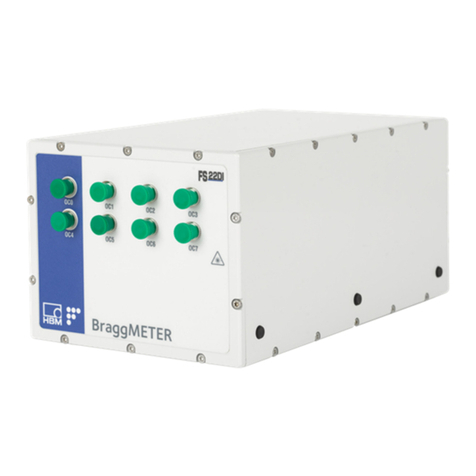
HBK
HBK FS22DI quick start guide
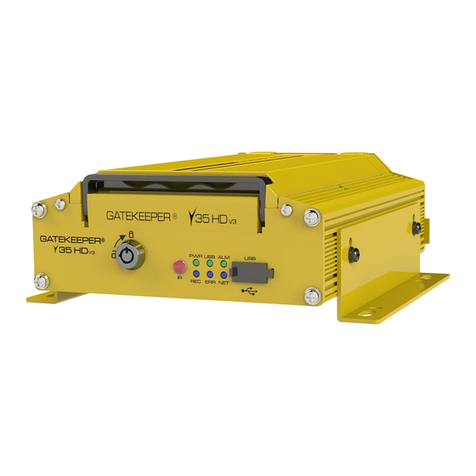
Gatekeeper
Gatekeeper Y35 HD v3 User manual & installation guidelines

Thermo Scientific
Thermo Scientific 42i instruction manual

Kentec Electronics
Kentec Electronics DNX-A-2R-K user manual

Tempo Communications
Tempo Communications OFL100 instruction manual
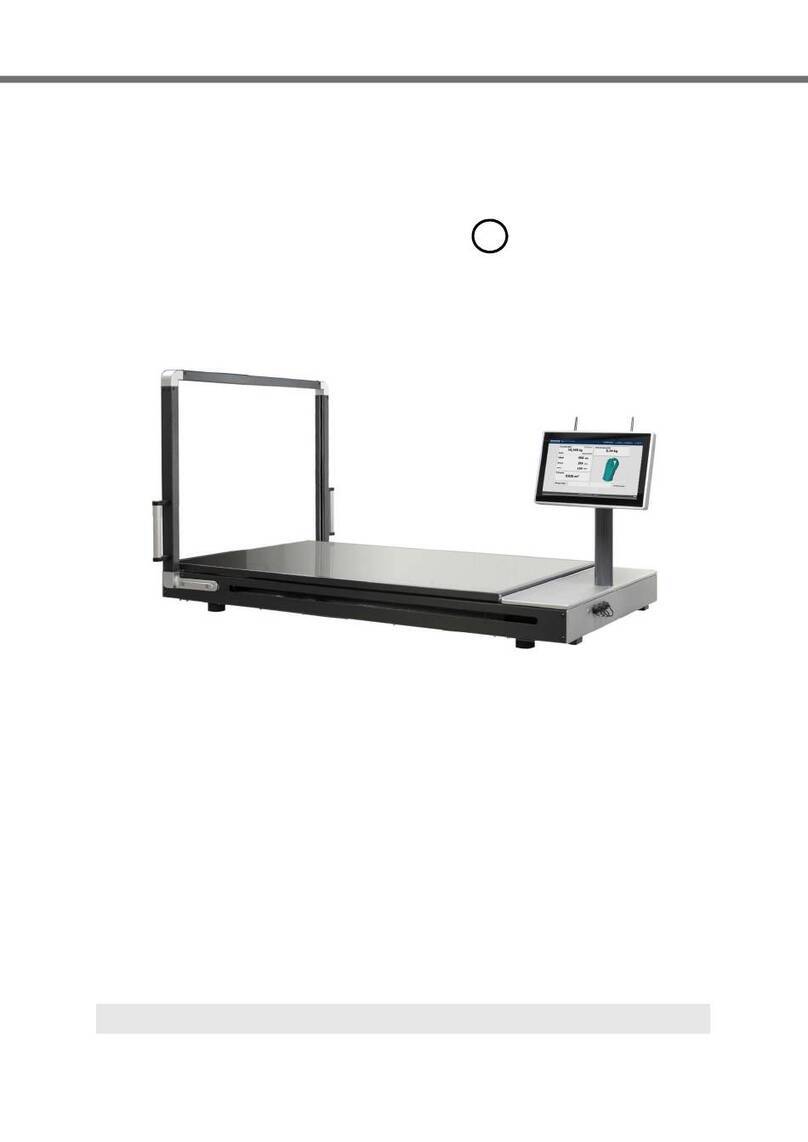
Bosche
Bosche zippcube S operating manual
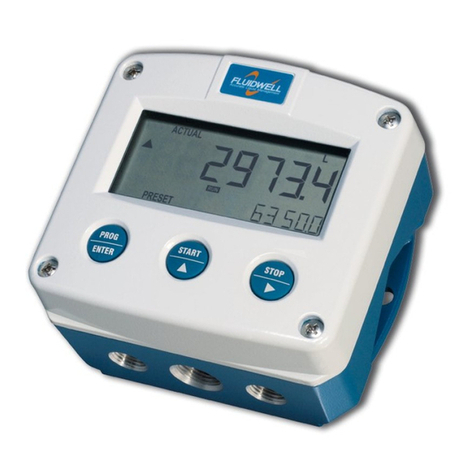
Fluidwell
Fluidwell F Series manual
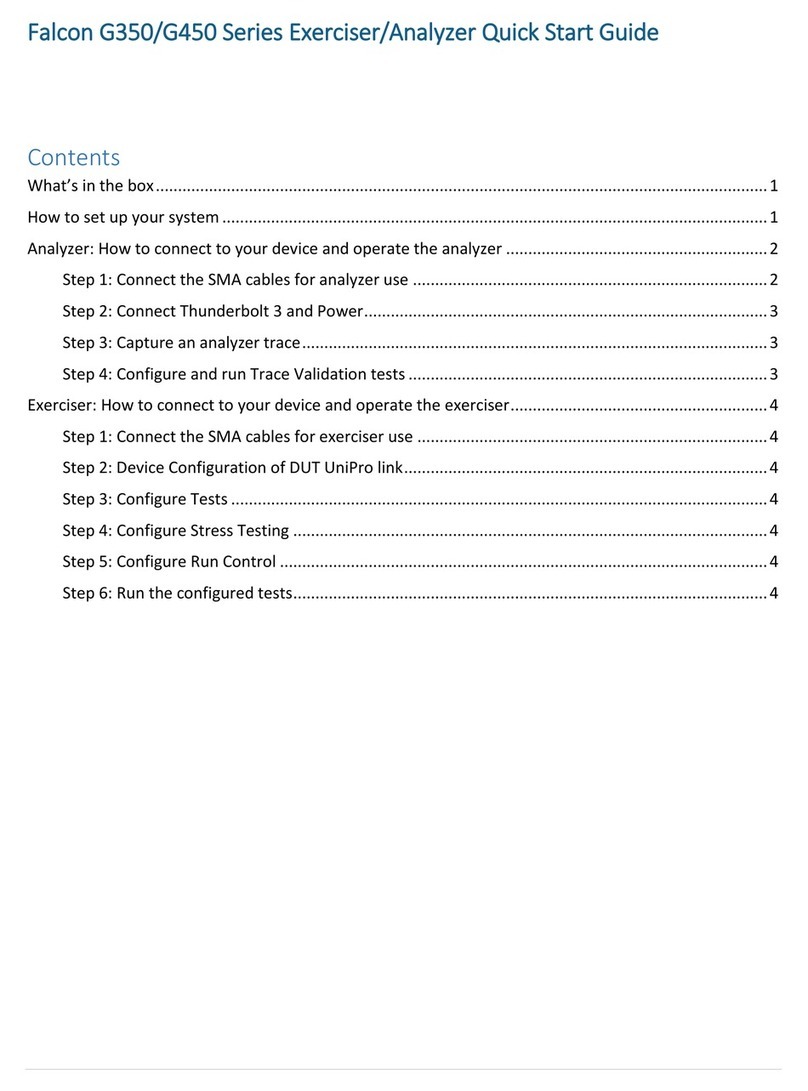
Falcon
Falcon G350 series quick start guide
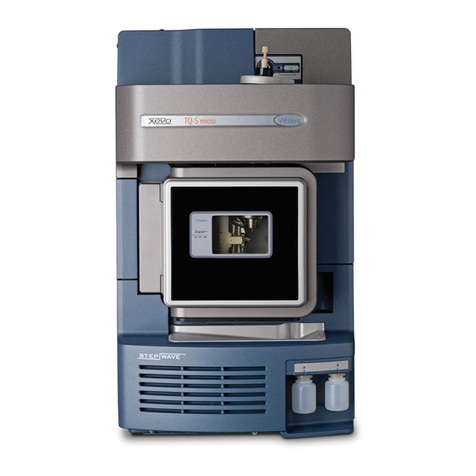
Waters
Waters Xevo TQ-S micro Overview and maintenance guide
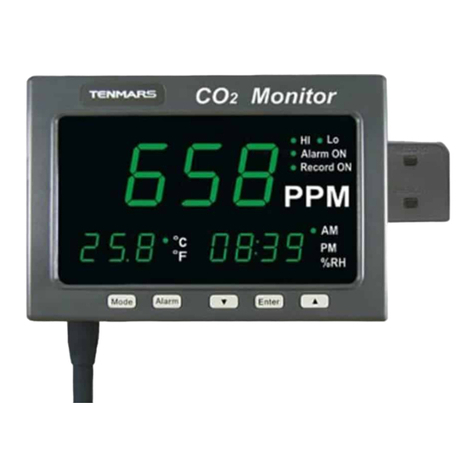
Tenmars
Tenmars TM-186 user manual

American Innovations
American Innovations APM4AM-SAT WS Installation and configuration guide
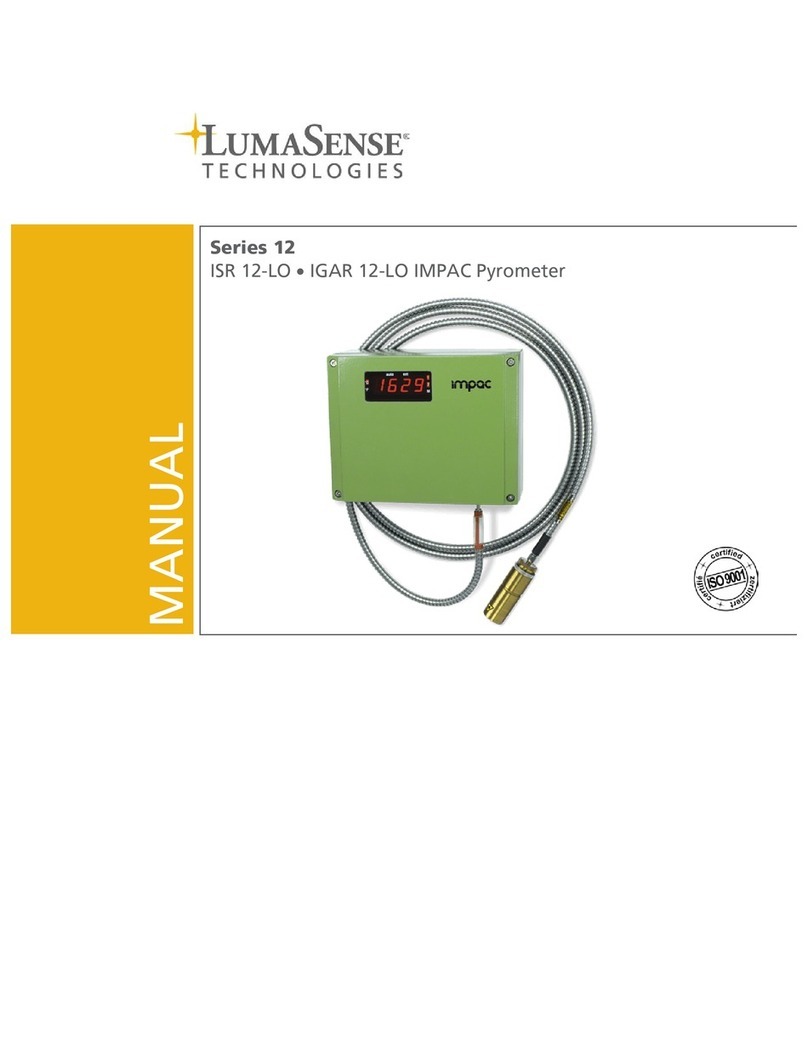
LumaSense technologies
LumaSense technologies IGAR 12-LO manual
